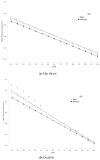Should We Use the Men Load-Velocity Profile for Women in Deadlift and Hip Thrust?
- PMID: 36981796
- PMCID: PMC10048953
- DOI: 10.3390/ijerph20064888
Should We Use the Men Load-Velocity Profile for Women in Deadlift and Hip Thrust?
Abstract
Injuries are common in team sports and can impact both team and individual performance. In particular, hamstring strain injuries are some of the most common injuries. Furthermore, hamstring injury ratios, in number of injuries and total absence days, have doubled in the last 21 seasons in professional soccer. Weakness in hip extensor strength has been identified as a risk factor in elite-level sprinters. In addition, strength imbalances of the hamstring muscle group seem to be a common cause of hamstring strain injuries. In this regard, velocity-based training has been proposed to analyze deficits in the force-velocity profile. Previous studies have shown differences between men and women, since there are biomechanical and neuromuscular differences in the lower limbs between sexes. Therefore, the aim of this study was to compare the load-velocity profile between males and females during two of the most important hip extension exercises: the hip thrust and the deadlift. Sixteen men and sixteen women were measured in an incremental loading test following standard procedures for the hip thrust and deadlift exercises. Pearson's correlation (r) was used to measure the strength of the correlation between movement velocity and load (%1RM). The differences in the load-velocity relationship between the men and the women were assessed using a 2 (sex) × 15 (load) repeated-measures ANOVA. The main findings revealed that: (I) the load-velocity relationship was always strong and linear in both exercises (R2 range: 0.88-0.94), (II) men showed higher velocities for light loads (30-50%1RM; effect size: 0.9-0.96) than women for the deadlift, but no significant differences were found for the hip thrust. Based on the results of this study, the load-velocity equations seem to be sex-specific. Therefore, we suggest that using sex-specific equations to analyze deficits in the force-velocity profile would be more effective to control intensity in the deadlift exercise.
Keywords: hamstrings; injuries; sex differences; velocity-based training.
Conflict of interest statement
The authors declare no conflict of interest.
Figures


Similar articles
-
Load-velocity relationship of the deadlift exercise.Eur J Sport Sci. 2021 May;21(5):678-684. doi: 10.1080/17461391.2020.1785017. Epub 2020 Aug 6. Eur J Sport Sci. 2021. PMID: 32552373
-
The load-velocity profile differs more between men and women than between individuals with different strength levels.Sports Biomech. 2019 Jun;18(3):245-255. doi: 10.1080/14763141.2018.1433872. Epub 2018 Mar 21. Sports Biomech. 2019. PMID: 29558855
-
Comparison Between Back Squat, Romanian Deadlift, and Barbell Hip Thrust for Leg and Hip Muscle Activities During Hip Extension.J Strength Cond Res. 2019 Oct;33(10):2595-2601. doi: 10.1519/JSC.0000000000003290. J Strength Cond Res. 2019. PMID: 31356511
-
Gluteus Maximus Activation during Common Strength and Hypertrophy Exercises: A Systematic Review.J Sports Sci Med. 2020 Feb 24;19(1):195-203. eCollection 2020 Mar. J Sports Sci Med. 2020. PMID: 32132843 Free PMC article.
-
Resistance Training Intensity Prescription Methods Based on Lifting Velocity Monitoring.Int J Sports Med. 2024 Apr;45(4):257-266. doi: 10.1055/a-2158-3848. Epub 2023 Aug 22. Int J Sports Med. 2024. PMID: 37607576 Review.
Cited by
-
Sex Differences in the Load-Velocity Profiles of Three Different Row Exercises.Sports (Basel). 2023 Nov 9;11(11):220. doi: 10.3390/sports11110220. Sports (Basel). 2023. PMID: 37999437 Free PMC article.
-
Road to Paris 2024: force-velocity profile in different speed climbers' abilities.Biol Sport. 2024 Mar;41(2):131-137. doi: 10.5114/biolsport.2024.131824. Epub 2023 Oct 16. Biol Sport. 2024. PMID: 38524813 Free PMC article.
-
Sex differences in the rate of torque development and torque-velocity relationship are due to maximal strength only.Eur J Appl Physiol. 2025 Jun 10. doi: 10.1007/s00421-025-05836-9. Online ahead of print. Eur J Appl Physiol. 2025. PMID: 40493173
References
MeSH terms
LinkOut - more resources
Full Text Sources

